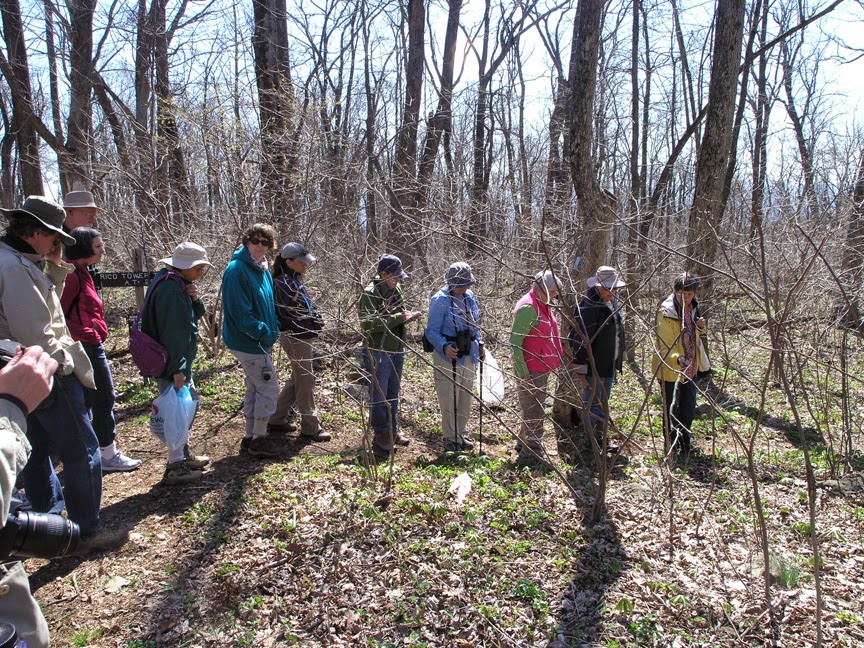 |
| VNPS members on the Trillium Trail |
On the last Sunday in April I hiked the Trillium Trail at Thompson Wildlife Management Area (Thompson WMA) with the Piedmont Chapter of the Virginia Native Plant Society (VPNS). Spring is so late this year that the thousands of trilliums (Trillium grandiflora) this area is famous for were barely out of the ground; only a few blossoms here and there and a few patches in the sunnier part of the lower portion of the hill were visible. At this higher elevation the tree leaves had not begun to unfurl yet, and it was much chillier at the top of the ridge than in the valley below.
Our hike leader Sally said that at one time it was thought that the trillium flowers started out as pure white and turned pink with age, but this is actually not so. Seeing is believing, and here was the proof--many of the just-emerging blossoms were a soft pink in bud and recently-opened blossom. I've heard theories that the trilliums in this huge stand are the result of many years of natural hybridization of several species such as T. grandiflora with T. erectum, but botanically, the pink variety is classified as T. grandiflora forma roseum and wavy edges on the flower are one characteristic of this variant.
 |
| Pink Trillium bud (Trillium grandiflora forma roseum) |
We took the side trail leading to the Appalachian Trail (AT) with Sally pointing out many interesting plants, some of which I was familiar with, and others unknown to me, including a native mustard that is the host plant for the West Virginia White butterfly (Pieris virginiensis). I didn't know that this native butterfly has been steadily declining since the 1990's, and one reason is that the butterfly seems to get confused and lays its eggs on that invasive plague, garlic mustard, instead of its host plant. The caterpillars cannot survive on garlic mustard, and when the butterfly does not reproduce, the population in those areas can be wiped out.
A lady who befriended me on the previous hike, Mary Keith, told me that the Piedmont Chapter maintains the Trillium Trail to try to keep the garlic mustard under control, and sure enough, as we walked she and several other ladies pulled up any traces of the noxious invader we came across and bagged them to dispose of them later. Evidently garlic mustard is so programmed for survival that even after being pulled up, any flowers on the stems can set seed and spread, so the plants can't be left lying around on the ground.
Turning left onto the AT we encountered many early spring ephemerals blooming along trail: bloodroot, wild ginger, blue and smooth yellow violets, and Canada mayflower.
 |
| Bloodroot flower (Sanguinaria canadensis) |
 |
| Wild ginger flower (Asarum canadense) |
 |
| Canada mayflower (Maianthemum canadense) |
 |
| Blue and Smooth Yellow Violets. |
I looked for the Showy orchid, hoping to catch a glimpse of some and eventually I spotted one nice clump emerging by the side of the trail. The fleshy leaves formed a curious vase-like cup with the tiny flower spike bud barely visible inside.
 |
| Showy orchid (Galearis spectabilis) emerging from forest floor |
Further down the hill we encountered a seep, full of skunk cabbage and other interesting plants, among them the false hellebore I had seen last year at Big Meadows on Skyline Drive, and another type of saxifrage with toothed leaf margins.
 |
| False Hellebore (Veratrum viride) |
At the junction of the AT with the fire road we turned left to go up the hill. Many huge trees had come down during the harsh winter, the dead trunks and branches strewn all over the ground, cut only to allow passage on the fire road. The lumber on the ground obscured most of the areas where I'd seen Yellow Lady Slipper orchids in years past, but I found a few orchid plants emerging from the leaf litter. At this stage, the plant would have been difficult to identify if I hadn't known the location
 |
| Yellow Lady Slipper orchid emerging from the forest floor. |
As we were approaching the end of our circular hike, near the parking area, a patch lovely of trout lilies greeted us by way of bidding our group good-bye. These plants had quite a few leaves, more than the usual two per blooming plant.






